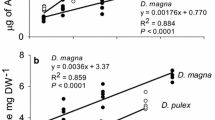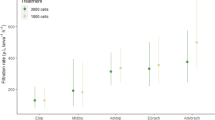Abstract
Three species of phytoplankton grown at high (HL) or low light (LL) were fed as saturating rations to laboratory-reared larval Crassostrea gigas. Larval C. gigas fed diets of HL grown Chaetoceros gracilis and HL grown Isochrysis aff. galbana grew faster than those fed LL grown cells of the same phytoplankton species. Faster growth of C. gigas larvae was consistently associated with increases in the percent composition of short chain saturated fatty acids (FA) 14:0+16:0 in the HL grown cells. There were no consistent and significant differences between HL and LL grown phytoplankton cells in their content of carbon, nitrogen, protein, lipid or carbohydrate. Intraspecific increases in percent composition of essential fatty acids (EFAs), 20:5ω3 and 22:6ω3, in the phytoplankton were not associated with improvements in the growth or survival of the oyster larvae. Oyster larvae fed diets of Phaeodactylum tricornutum with a relatively high proportion of EFAs grew more slowly than those fed C. gracilis. In this experiment the proportion of dietary EFA 20:5ω3 was negatively correlated with oyster growth rates. The faster growing oyster larvae contained relatively more of the FAs 14:0+16:0 which may be useful as measures of larval oyster condition. After a diet of one phytoplankton species for ca. 10 d, oyster larvae acquired distinctive FA profiles resembling that of their phytoplankton prey.
Similar content being viewed by others
Literature cited
Ackman, R. G. (1986). WCOT (capillary) gas-liquid chromatography. In: Hamilton, R. J., Rossell, J. B. (eds.) Analysis of oils and fats. Elsevier Applied Science Publ., New York, p. 137–206
Ackman, R. G., Hooper, S. N. (1973). Non-methylene-interrupted fatty acids in lipids of shallow-water marine invertebrates: a comparison of two molluscs (Littorina littorina, and Lunatia triseriata) with the sand shrimp (Crangon septemspinosus). Comp. Biochem. Physiol. 46B: 153–155
Ackman, R. G., Tocher, C. S., McLachlan, J. (1968). Marine phytoplankter fatty acids. J. Fish. Res. Bd Can. 25: 1603–1620
Bligh, E. G., Dyer, W. J. (1959). A rapid method of total lipid extraction and purification. Can. J. Biochem. Physiol. 37: 911–917
Breese, W. P., Malouf, R. E. (1975). Hatchery manual for the Pacific Oyster. Oregon State University Sea Grant College Program Publication no. ORESU-H-75002, Corvallis, Oregon
Cohen, Z., Vonshak, A., Richmond, A, (1988). Effect of environmental conditions on the fatty acid composition of the red alga Porphyridium cruetum: correlation to growth rate. J. Phycol. 24: 328–332
Cook, J. R. (1963). Adaptations in growth and division in Euglena affected by energy supply. J. Protozool. 10: 436–444
Creekman, L. L. (1977). The effects of conditioning the American oyster (Crassostrea virginica) with Tetraselmis suecica and cornstarch on the growth, vigor and survival of its larvae. M. A. Thesis, University of Virginia, Charlottesville, Virginia, U.S.A.
Dickey-Collas, M., Geffen, A. J. (1992). Importance of the fatty acids 20:5ω3 and 22:6ω3 in the diet of plaice (Pleuronectes platessa) larvae. Mar. Biol. 113: 463–468
Dortch, Q., Clayton, Jr., J. R., Thoresen, S. S., Ahmed, S. I. (1984). Species differences in accumulation of nitrogen pools in phytoplankton. Mar. Biol. 81: 237–250
Dubios, M., Giles, K. A., Hamilton, J. K., Rebers, P. A., Smith, F. (1956). Colormetric determination for sugars and related substances. Analyt Chem. 28: 350–356
Enright, C. T., Newkirk, G. F., Craigie, J. S., Castell, J. D. (1986). Evaluation of phytoplankton as diets for juvenile Ostrea edulis L. J. exp. mar. Biol. Ecol. 96: 1–13
Gabbott, P. A., Holland, D. L. (1972). Growth and metabolism of Ostrea edulis larvae. Nature, Lond. 241: 475–476
Gallager, S. M., Mann, R. (1986). Growth and survival of larvae of Mercenaria mercenaria (L) and Crassostrea virginica (Gemlin) relative to broodstock conditioning and lipid content of eggs. Aquaculture, Amsterdam 56: 103–121
Gallager, S. M., Mann, R., Sasaki, G. C. (1986). Lipid as an index of growth and viability in three species of bivalve larvae. Aquaculture, Amsterdam 56: 81–103
Goulden, C. E., Place, A. R. (1990). Fatty acid synthesis and accumulation rates in Daphiniids. J. exp. Zool. 256: 168–178
Harrison, P. J., Waters, R. E., Taylor, F. J. R. (1980). A broad spectrum artificial seawater medium for coastal and open ocean phytoplankton. J. Phycol. 16: 28–35
Holland, D. L. (1978). Lipid reserves and energy metabolism in the larvae of benthic marine invertebrates. In Malins, D. C., Sargent, J. R. (eds.) Biochemical and biophysical perspectives in marine biology, Vol. 4. Academic Press, N.Y., p. 85–123
Holland, D. L., Spencer, B. E. (1973). Biochemical changes in fed and starved oysters Ostrea edulis during larval development, metamorphosis and early spat growth. J. mar. biol. Ass. U.K. 53: 287–298
Klingensmith, J. S. (1982). Distribution of methylene and nonmethylene interrupted dieonic fatty acids in polar lipids and triacylglycerols of selected tissue of the hardshell clam (Mercenaria mercenaria). Lipids 17: 976–981
Langdon, C. J., Waldock, M. J. (1981). The effect of algal and artifical diets on the growth and fatty acid composition of Crassostrea gigas spat. J. mar. biol. Ass. U.K. 61: 431–448
Lehninger, A. L. (1982). Principles of biochemistry. Worth Publishers, New York
Lowry, O. H., Rosebrough, N. J., Farr, A. L., Randall, R. J. (1951). Protein measurement with the Folin phenol reagent. J. biol. Chem. 193: 265–275
Mortensen, S. H., Borsheim, K. Y., Rainuzzo, R. R., Knutsen, G. (1988). Fatty acid and elemental composition of the marine diatom Chaetoceros gracilis Schutt. Effects of silicate deprivation, temperature and light intensity. J. exp. mar. Biol. Ecol. 122: 173–185
Nichols, P. D., Skerrati, J. H., Davidson, A., Burton, H. McMeekin, T. A. (1991). Lipids of cultured Phaeocytis pouchettii: signatures for food-web biogeochemical and environmental studies in Antarctica and the Southern Ocean. Phytochem. 30: 3209–3214
Crcutt, D. M., Patterson, G. W. (1974). Effect of light intensity upon lipid composition of Nitzschia closterium (Cylindrotheca fusiformis). Lipids 9: 1000–1003
Orcutt, D. M., Patterson, G. W. (1975). Sterol, fatty acid and elemental composition of diatoms grown in chemically defined media. Comp. Biochem. Physiol. 50B: 579–583
Østgaard, K., Støren, O., Grimsrud, K., Brokstad, R. (1987). Microcomputer-assisted systems for recording and control of growing phytoplankton cultures. J. Plankton Res. 9: 1075–1092
Parsons, T. R., Maita, Y., Lalli, C. M. (1984). A manual of chemical and biological methods for seawater analysis. Pergamon Press, New York
Parsons, T. R., Stephens, K., Strickland, J. D. H. (1961). On the chemical composition of eleven species of marine phytoplankters. J. Fish. Res. Bd Can. 18: 1001–1016
Sukenik, A., Carmeli, Y., Berner, T. (1989). Regulation of fatty acid composition by irradiance level in the Eustigmatophyte Nannochloropsis sp. J. Phycol. 25: 686–692
Thompson, P. A., Guo, M-X, Harrison, P. J., Whyte, J. N. C. (1992). Effects of variation in temperature. II. On the fatty acid composition of eight species of marine phytoplankton. J. Phycol. 28: 488–497
Thompson, P. A., Harrison, P. J. (1992). Effects of monospecific diets of varying biochemical composition on the growth and survival of Pacific oyster (Crassostrea gigas) larvae. Mar. Biol. 113: 645–654
Thompson, P. A., Harrison, P. J., Parslow, J. S. (1991). Influence of irradiance on cell colume and carbon quota for ten species of marine phytoplankton. J. Phycol. 27: 351–360
Thompson, P. A., Harrison, P. J., Whyte, J. N. C. (1990). The influence of irradiance on the fatty acid composition of phytoplankton. J. Phycol. 26: 278–288
Utting, S. D. (1986). A preliminary study on growth of Crassostrea gigas larvae and spat in relation to dietary protein. Aquaculture, Amsterdam 56: 123–138
Volkman, J. K., Jeffery, S. W., Nichols, P. D., Rogers, G. I., Garland, C. D. (1989). Fatty acid and lipid composition of 10 species of microalgae used in aquaculture. J. exp. mar. Biol. Ecol. 128: 219–240
Waldock, M. J., Nascimento, I. A. (1979). The triacylglycerol composition of Crossostrea gigas larvae fed on different diets. Mar. Biol. Lett. 1: 77–88
Walne, P. R. (1974). The culture of bivalve molluscs: 50 years of experience at Conwy. Fishing News, West Byfleet
Webb, K. L., Chu, F-L. E. (1982). Phytoplankton as a food source for bivalve larvae. In: Pruder, G. D., Langdon, C., Conklin, D. (eds.) Biochemical and physiological approaches to shellfish nutrition. Proceedings of the Second International Conference on Aquaculture Nutrition, Louisiana State Univ. Press, Baton Rouge, p. 272–291
Whyte, J. N. C. (1988). Fatty acid profiles from direct methanolysis of lipids in tissue of cultured species. Aquaculture, Amsterdam 75: 193–203
Author information
Authors and Affiliations
Additional information
Communicated by R. J. Thompson, St. John's
Rights and permissions
About this article
Cite this article
Thompson, P.A., Guo, M. & Harrison, P.J. The influence of irradiance on the biochemical composition of three phytoplankton species and their nutritional value for larvae of the Pacific Oyster (Crassostrea gigas). Marine Biology 117, 259–268 (1993). https://doi.org/10.1007/BF00345671
Received:
Accepted:
Issue Date:
DOI: https://doi.org/10.1007/BF00345671




